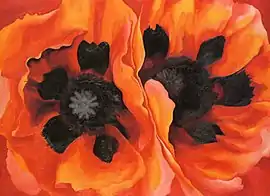Oriental Poppies
Oriental Poppies, also called Red Poppies, is a 1927 oil-on-canvas painting by Georgia O'Keeffe.[1][2][3][lower-alpha 1] It is a close-up of two Papaver orientale flowers that fill the entire canvas.[1]
| Oriental Poppies | |
|---|---|
 | |
| Artist | Georgia O'Keeffe |
| Year | 1927 |
| Medium | Oil on canvas |
| Dimensions | 101.6 cm × 76.2 cm (40.0 in × 30.0 in) |
| Location | Weisman Art Museum |
Description
The Arts Desk describes it as more subtle but equally powerful as Calla Lilies on Red, "Peering into the bright-orange petals, O’Keeffe reveals the velvety dark interior. The drama of this provocative image stems from the juxtaposition of vivid color and intrusive close-up."[4] Of the large close-up, O'Keeffe said that she decided that she would paint flowers "big and they will be surprised into taking time to look at it - I will make even busy New Yorkers take time to see what I see of flowers."[3] Making close-ups of flowers is said to have been influenced by her husband Alfred Stieglitz, a photographer, after they began a more sexual relationship.[7]
Along with Black Iris, Liese Spencer of The Guardian calls it one of "her lush, sensual paintings of flowers."[8] It fills the nearly four foot wide canvas, without a background, so that the flowers "explode" on the canvas, and direct the eye to the center of the flowers. It is among her most famous works of art.[6]
Collection
The painting is owned by the Weisman Art Museum of the University of Minnesota,[1] where as of July 2016 it was the most valuable painting in their collection.[9] Prior to its acquisition in 1937, it was exhibited by Stieglitz at his gallery, An American Place, in New York City.[1][10]
Exhibitions
In 2016, Tate Modern in London exhibited Oriental Poppies along with more than 100 of O'Keeffe's major works of art, made over six decades.[7] The exhibition was also held at the Bank Austria Kunstforum in Vienna that year.[11]
Notes
- The Arts Desk states that the painting was made in 1927,[4] as does The Guardian,[5] who also states in another article that it was made in 1928.[6]
References
- "Oriental Poppies, (painting)". Smithsonian Institution Research Information System (SIRIS). Retrieved January 13, 2017.
- Britta Benke (2000). Georgia O'Keeffe, 1887-1986: Flowers in the Desert. Taschen. pp. 37–38, 39. ISBN 978-3-8228-5861-5.
- "Georgia O'Keeffe Biography". Biography Channel. A&E Television Networks. August 26, 2016. Retrieved January 13, 2017.
- Sarah Kent (July 5, 2016). "Georgia O'Keeffe, Tate Modern". The Arts Desk. Retrieved January 13, 2017.
- "Georgia O'Keeffe at Tate Modern review – one long, strange trip". The Guardian. July 4, 2016. Retrieved January 13, 2017.
- Laura Cumming (April 7, 2012). "The 10 best flower paintings – in pictures". The Guardian. Retrieved January 13, 2017.
- Sonia Kolesnikov-Jessop (July 5, 2015). "Video: A Tour of Georgia O'Keeffe Retrospective at Tate Modern, London". Blouin Art. Retrieved January 13, 2017.
- Liese Spencer (December 31, 2015). "From Georgia O'Keeffe to War and Peace: unmissable arts events in 2016". The Guardian. Retrieved January 13, 2017.
- Susan Mulcahy (July 27, 2016). "A Prized Stettheimer Painting, Sold Under the Radar by a University". The New York Times. Retrieved January 13, 2017.
- "Oriental Poppies: WAM Urban Myth Buster". The WAM Files, Library, University of Minnesota. February 22, 2012. Retrieved January 13, 2017.
- Stefan Dege (September 12, 2016). "Why Georgia O'Keeffe was a pioneer of American art". Deutsche Welle. Retrieved January 13, 2017.